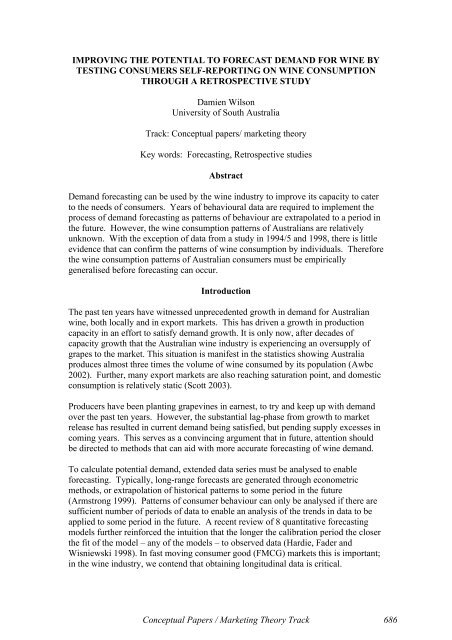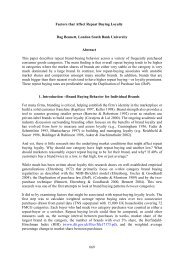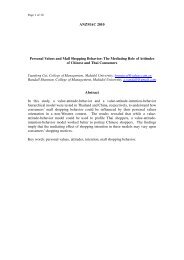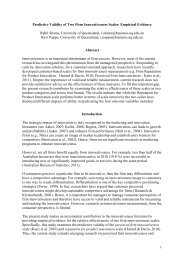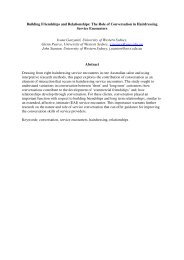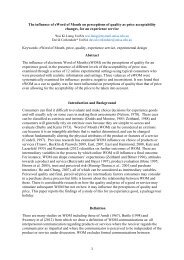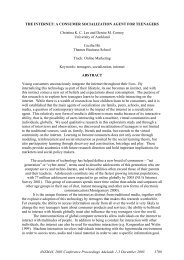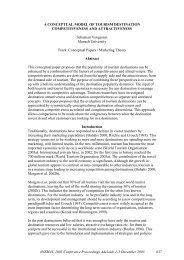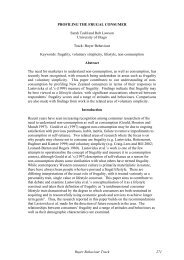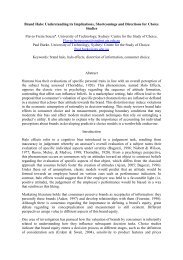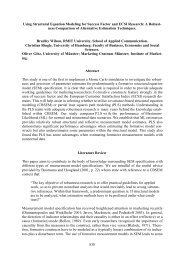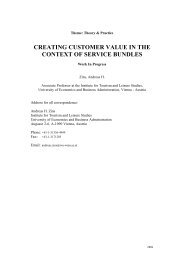improving the potential to forecast demand for wine by ... - ANZMAC
improving the potential to forecast demand for wine by ... - ANZMAC
improving the potential to forecast demand for wine by ... - ANZMAC
You also want an ePaper? Increase the reach of your titles
YUMPU automatically turns print PDFs into web optimized ePapers that Google loves.
IMPROVING THE POTENTIAL TO FORECAST DEMAND FOR WINE BY<br />
TESTING CONSUMERS SELF-REPORTING ON WINE CONSUMPTION<br />
THROUGH A RETROSPECTIVE STUDY<br />
Damien Wilson<br />
University of South Australia<br />
Track: Conceptual papers/ marketing <strong>the</strong>ory<br />
Key words: Forecasting, Retrospective studies<br />
Abstract<br />
Demand <strong><strong>for</strong>ecast</strong>ing can be used <strong>by</strong> <strong>the</strong> <strong>wine</strong> industry <strong>to</strong> improve its capacity <strong>to</strong> cater<br />
<strong>to</strong> <strong>the</strong> needs of consumers. Years of behavioural data are required <strong>to</strong> implement <strong>the</strong><br />
process of <strong>demand</strong> <strong><strong>for</strong>ecast</strong>ing as patterns of behaviour are extrapolated <strong>to</strong> a period in<br />
<strong>the</strong> future. However, <strong>the</strong> <strong>wine</strong> consumption patterns of Australians are relatively<br />
unknown. With <strong>the</strong> exception of data from a study in 1994/5 and 1998, <strong>the</strong>re is little<br />
evidence that can confirm <strong>the</strong> patterns of <strong>wine</strong> consumption <strong>by</strong> individuals. There<strong>for</strong>e<br />
<strong>the</strong> <strong>wine</strong> consumption patterns of Australian consumers must be empirically<br />
generalised be<strong>for</strong>e <strong><strong>for</strong>ecast</strong>ing can occur.<br />
Introduction<br />
The past ten years have witnessed unprecedented growth in <strong>demand</strong> <strong>for</strong> Australian<br />
<strong>wine</strong>, both locally and in export markets. This has driven a growth in production<br />
capacity in an ef<strong>for</strong>t <strong>to</strong> satisfy <strong>demand</strong> growth. It is only now, after decades of<br />
capacity growth that <strong>the</strong> Australian <strong>wine</strong> industry is experiencing an oversupply of<br />
grapes <strong>to</strong> <strong>the</strong> market. This situation is manifest in <strong>the</strong> statistics showing Australia<br />
produces almost three times <strong>the</strong> volume of <strong>wine</strong> consumed <strong>by</strong> its population (Awbc<br />
2002). Fur<strong>the</strong>r, many export markets are also reaching saturation point, and domestic<br />
consumption is relatively static (Scott 2003).<br />
Producers have been planting grapevines in earnest, <strong>to</strong> try and keep up with <strong>demand</strong><br />
over <strong>the</strong> past ten years. However, <strong>the</strong> substantial lag-phase from growth <strong>to</strong> market<br />
release has resulted in current <strong>demand</strong> being satisfied, but pending supply excesses in<br />
coming years. This serves as a convincing argument that in future, attention should<br />
be directed <strong>to</strong> methods that can aid with more accurate <strong><strong>for</strong>ecast</strong>ing of <strong>wine</strong> <strong>demand</strong>.<br />
To calculate <strong>potential</strong> <strong>demand</strong>, extended data series must be analysed <strong>to</strong> enable<br />
<strong><strong>for</strong>ecast</strong>ing. Typically, long-range <strong><strong>for</strong>ecast</strong>s are generated through econometric<br />
methods, or extrapolation of his<strong>to</strong>rical patterns <strong>to</strong> some period in <strong>the</strong> future<br />
(Armstrong 1999). Patterns of consumer behaviour can only be analysed if <strong>the</strong>re are<br />
sufficient number of periods of data <strong>to</strong> enable an analysis of <strong>the</strong> trends in data <strong>to</strong> be<br />
applied <strong>to</strong> some period in <strong>the</strong> future. A recent review of 8 quantitative <strong><strong>for</strong>ecast</strong>ing<br />
models fur<strong>the</strong>r rein<strong>for</strong>ced <strong>the</strong> intuition that <strong>the</strong> longer <strong>the</strong> calibration period <strong>the</strong> closer<br />
<strong>the</strong> fit of <strong>the</strong> model – any of <strong>the</strong> models – <strong>to</strong> observed data (Hardie, Fader and<br />
Wisniewski 1998). In fast moving consumer good (FMCG) markets this is important;<br />
in <strong>the</strong> <strong>wine</strong> industry, we contend that obtaining longitudinal data is critical.<br />
Conceptual Papers / Marketing Theory Track 686
Un<strong>for</strong>tunately, <strong>the</strong> patterns of <strong>wine</strong> consumption are relatively unknown as <strong>the</strong>re is<br />
little empirical evidence of <strong>the</strong> habits of <strong>wine</strong> consumers. There are two studies on<br />
<strong>the</strong> population’s <strong>wine</strong> consumption habits, from <strong>the</strong> Australian Bureau of Statistics<br />
(ABS) in 1994/5 and 1998, but in isolation, <strong>the</strong>se cross-sectional studies are of little<br />
use in <strong><strong>for</strong>ecast</strong>ing <strong>demand</strong>. However, an argument can be made that if consumers’<br />
his<strong>to</strong>rical patterns of <strong>wine</strong> consumption can be confirmed with data from <strong>the</strong>se two<br />
samples, empirical evidence on <strong>wine</strong> consumption could be generated retrospectively.<br />
Consequently, this study proposes <strong>the</strong> use of a retrospective survey method as a way<br />
of investigating consumers’ <strong>wine</strong> consumption habits over <strong>the</strong>ir lives.<br />
Evidence of retrospective studies in marketing is difficult <strong>to</strong> find. However, <strong>the</strong><br />
process of a retrospective cohort study is well established in <strong>the</strong> field of<br />
epidemiology. This paper suggests <strong>the</strong> his<strong>to</strong>rical consumption patterns of Australians<br />
are investigated using <strong>the</strong> established methodology <strong>for</strong> a retrospective cohort study.<br />
The findings can be tested against <strong>the</strong> data provided <strong>by</strong> <strong>the</strong> ABS in 1994/5 and 1998<br />
<strong>for</strong> validity of <strong>the</strong> study.<br />
This study contributes <strong>to</strong> <strong>the</strong> development of a new methodology <strong>for</strong> validating <strong>the</strong><br />
behaviours of consumers in past periods. Additionally, if consumers can be shown <strong>to</strong><br />
recall <strong>the</strong>ir <strong>wine</strong> consumption patterns, <strong>the</strong>ir patterns of consumption can be<br />
evaluated, and <strong><strong>for</strong>ecast</strong>ing of future consumption can be made with improved<br />
accuracy.<br />
The first section of this paper explains <strong>the</strong> background <strong>to</strong> <strong>demand</strong> <strong><strong>for</strong>ecast</strong>ing and <strong>the</strong><br />
benefits of <strong>the</strong> process <strong>for</strong> industry. The second section highlights <strong>the</strong> in<strong>for</strong>mation<br />
required <strong>for</strong> applying <strong>the</strong> principles of <strong>demand</strong> <strong><strong>for</strong>ecast</strong>ing. The third section outlines<br />
<strong>the</strong> goal of generating empirical data on his<strong>to</strong>rical <strong>wine</strong> consumption. The next<br />
section details <strong>the</strong> methodology used in epidemiology <strong>for</strong> surveying respondents on<br />
<strong>the</strong>ir retrospective behaviours, and how it can be applied <strong>to</strong> this study. The final<br />
section summarises <strong>the</strong> concept of this paper be<strong>for</strong>e suggesting fur<strong>the</strong>r directions <strong>for</strong><br />
this study.<br />
Demand Forecasting<br />
Demand <strong><strong>for</strong>ecast</strong>ing is <strong>the</strong> process of using his<strong>to</strong>rical data on consumption in order <strong>to</strong><br />
anticipate future <strong>demand</strong> <strong>for</strong> a product or service (Smith, Herbig, Milewicz and<br />
Golden 1996; Armstrong 1999). Industries budget <strong>for</strong> <strong>potential</strong> <strong>demand</strong> as a way <strong>to</strong><br />
allocate resources <strong>to</strong> a firm’s operations. However, <strong>to</strong> enable a reliable <strong><strong>for</strong>ecast</strong> of<br />
<strong>demand</strong>, <strong>the</strong> approximate number of consumers and <strong>the</strong>ir probability of consumption<br />
need <strong>to</strong> be known <strong>by</strong> <strong>the</strong> <strong><strong>for</strong>ecast</strong>er (Massy 1969). The problem in <strong>the</strong> <strong>wine</strong> industry<br />
in Australia is that nei<strong>the</strong>r of that in<strong>for</strong>mation is available as <strong>the</strong>re is little data on <strong>the</strong><br />
consumption habits of <strong>the</strong> population.<br />
Applications <strong>to</strong> <strong>the</strong> Wine Industry<br />
To <strong><strong>for</strong>ecast</strong> <strong>demand</strong> in <strong>the</strong> <strong>wine</strong> industry, <strong>the</strong>re are three main options: 1. Assume<br />
that production and consumption occur at <strong>the</strong> same time; 2. Use sales data, assuming<br />
that sales and consumption occur concurrently; or 3. Use actual consumption data.<br />
<strong>ANZMAC</strong> 2003 Conference Proceedings Adelaide 1-3 December 2003 687
For <strong>the</strong> first option, <strong>the</strong> production data from year <strong>to</strong> year is available from <strong>the</strong> ABS<br />
as ‘apparent [<strong>wine</strong>] consumption’ data (Abs 2003). The ABS has recorded apparent<br />
<strong>wine</strong> consumption habits of Australians since <strong>the</strong> early 1940s (Abs 2003). However,<br />
problems arise in that inven<strong>to</strong>ries in <strong>the</strong> distribution channel are not considered, nor is<br />
<strong>the</strong> <strong>potential</strong> that <strong>wine</strong> may be matured <strong>for</strong> up <strong>to</strong> five years after harvest be<strong>for</strong>e release<br />
<strong>to</strong> <strong>the</strong> market (Halliday and Johnson 1994).<br />
The second option of using sales data seems more appropriate. However, sales data is<br />
difficult <strong>to</strong> capture from all firms selling <strong>wine</strong> in <strong>the</strong> market. Fur<strong>the</strong>r, <strong>the</strong><br />
demographic characteristics of consumers are not provided. Additionally, <strong>the</strong><br />
consumer’s propensity <strong>to</strong> share <strong>wine</strong> with ano<strong>the</strong>r, or <strong>to</strong> offer <strong>the</strong> <strong>wine</strong> as a gift is not<br />
a consideration with this method. Authors have laid claims <strong>to</strong> knowledge on <strong>the</strong><br />
patterns of <strong>wine</strong> consumption, but <strong>the</strong>se figures have been based on sales data, not<br />
actual consumption. There is no doubt that <strong>wine</strong> sales have a close relationship with<br />
<strong>wine</strong> consumption. However, <strong>the</strong> relationship between sales and consumption is not<br />
clearly defined.<br />
This leaves <strong>the</strong> use of actual consumption data as <strong>the</strong> only viable option. The written<br />
his<strong>to</strong>ry of <strong>wine</strong> consumption in Australia asserts <strong>the</strong>se details: Up <strong>to</strong> <strong>the</strong> 1960s, <strong>wine</strong><br />
consumption is believed <strong>to</strong> have been dominated <strong>by</strong> <strong>for</strong>tified <strong>wine</strong> consumption<br />
(Johnson 1971; Bees<strong>to</strong>n 1994). The 1970s witnessed a growth in white <strong>wine</strong><br />
consumption, and this pattern is believed <strong>to</strong> have held through <strong>the</strong> 1980s and in<strong>to</strong> <strong>the</strong><br />
early 1990s (Gluckman 1986; Bees<strong>to</strong>n 1994; Cartiere 1997). The mid-90s saw <strong>the</strong><br />
pattern change <strong>to</strong> dominance in red <strong>wine</strong> production (Awbc 2002), and <strong>the</strong> existence<br />
of consumption data shows red <strong>wine</strong> becoming <strong>the</strong> preferred style of Australians<br />
(Stan<strong>for</strong>d 2000). These patterns seem quite clear. However, with <strong>the</strong> exception of<br />
Stan<strong>for</strong>d’s paper, all authors use <strong>the</strong>ir observations and knowledge of <strong>the</strong> <strong>wine</strong><br />
industry without supporting <strong>the</strong>se assertions with empirical evidence. Consequently,<br />
<strong>the</strong> actual patterns of <strong>wine</strong> consumption are relatively unknown.<br />
There<strong>for</strong>e, <strong>the</strong> problem associated with using actual <strong>wine</strong> consumption data is that<br />
very little of it exists. Fur<strong>the</strong>r complicating <strong>the</strong> problem is that years of detailed<br />
consumption data have <strong>to</strong> be used in order <strong>to</strong> make <strong><strong>for</strong>ecast</strong>s of <strong>potential</strong> <strong>demand</strong>.<br />
However, <strong>the</strong>re is some documented his<strong>to</strong>ry of <strong>wine</strong> consumption in Australia from<br />
<strong>the</strong> ABS. In late-1994 and early 1995 <strong>the</strong> ABS surveyed consumers on <strong>the</strong>ir actual<br />
alcohol consumption <strong>for</strong> <strong>the</strong> first time, repeating <strong>the</strong> study in 1998.<br />
Conceptual Papers / Marketing Theory Track 688
Epidemiology and Marketing<br />
There is some precedent <strong>for</strong> using epidemiological techniques in <strong>the</strong> marketing area.<br />
Indeed, <strong>the</strong> Bass Model (1969) draws on roots in epidemiology in describing <strong>the</strong><br />
manner in which a <strong>potential</strong> market adopts a new product, idea, concept over<br />
successive time periods (Mahajan and Muller 1979). However, <strong>the</strong> Bass model uses<br />
empirically generalised data <strong>to</strong> define patterns of adoption. In this study, <strong>the</strong> data is<br />
yet <strong>to</strong> be generated.<br />
In order <strong>to</strong> investigate patterns of consumption, a study needs <strong>to</strong> be conducted over a<br />
long period. Studies that use <strong>the</strong> same respondents over extended time-lines are<br />
known as longitudinal studies (Guest 1944, 1955, 1964; Alanko 1984; Kelsey,<br />
Thompson and Evans 1986; Hennekens and Buring 1987; Giovannucci, Colditz,<br />
Stampfer, Rimm, Litin, Sampson and Willett 1991; Shatzberg 1995; Neuman 1997;<br />
Godden 1999). The epidemiological methods of investigating respondents’<br />
behaviours over extended periods are a prospective cohort study, case-control study<br />
and retrospective cohort study. The details of each of <strong>the</strong>se methods are outlined<br />
below.<br />
A prospective cohort study [usually referred <strong>to</strong> as a cohort study] is where subjects<br />
are classified based on <strong>the</strong>ir exposure <strong>to</strong> a particular fac<strong>to</strong>r that is hypo<strong>the</strong>sised <strong>to</strong><br />
predetermine a course of action. The exposed and unexposed groups are <strong>the</strong>n<br />
moni<strong>to</strong>red over time <strong>for</strong> <strong>the</strong> development or o<strong>the</strong>rwise of <strong>the</strong> course of action being<br />
investigated (Hennekens and Buring 1987; Kahn and Sepos 1989).<br />
Retrospective studies are where an outcome is observed in a number of respondents.<br />
The respondents are questioned on <strong>the</strong>ir exposure or o<strong>the</strong>rwise <strong>to</strong> an [hypo<strong>the</strong>sised]<br />
influencing fac<strong>to</strong>r. Additionally, a comparable group of respondents who do not<br />
exhibit <strong>the</strong> outcome should also be queried as <strong>to</strong> any exposure <strong>to</strong> <strong>the</strong> influencing<br />
fac<strong>to</strong>r in an attempt <strong>to</strong> falsify a cause [or vice-versa] (Hennekens and Buring 1987;<br />
Kahn and Sepos 1989).<br />
“In a retrospective cohort study <strong>the</strong> investiga<strong>to</strong>r identifies a cohort of individuals based on <strong>the</strong>ir<br />
characteristics in <strong>the</strong> past and <strong>the</strong>n reconstructs <strong>the</strong>ir subsequent experience up <strong>to</strong> some defined point in<br />
<strong>the</strong> more recent past or up <strong>to</strong> <strong>the</strong> present time” (Kelsey et al. 1986)<br />
Retrospective cohort studies have advantages over prospective studies because cohort<br />
studies are conducted over long periods, and <strong>the</strong>re is a drop in respondent numbers<br />
over time. Consequently, any reduction in respondent numbers reduces <strong>the</strong><br />
generalisability of <strong>the</strong> results. Secondly, retrospective cohort studies can be<br />
completed in much more timely fashion and are considerably less expensive.<br />
Additionally, retrospective studies may be most applicable when extended timelines<br />
are required <strong>to</strong> determine effects (Kelsey et al. 1986).<br />
‘Exposure’ data may exist from previous periods, and in this instance, <strong>the</strong>y may be<br />
used <strong>to</strong> analyse <strong>the</strong> success of a retrospective study (Kahn and Sepos 1989). A<br />
problem of determining exposure <strong>to</strong> drivers of consumption in effect on an individual<br />
is that when using a retrospective study, <strong>the</strong> ability <strong>to</strong> apportion differing levels of<br />
exposure [<strong>to</strong> a driver of consumption] <strong>to</strong> individuals is not possible.<br />
<strong>ANZMAC</strong> 2003 Conference Proceedings Adelaide 1-3 December 2003 689
Researching Considerations<br />
In order <strong>to</strong> investigate patterns of an individual’s consumption, <strong>the</strong> same individual<br />
must provide in<strong>for</strong>mation on <strong>the</strong>ir consumption over time. As such, any study that<br />
requires <strong>the</strong> respondent <strong>to</strong> provide in<strong>for</strong>mation on more than one occasion risks <strong>the</strong><br />
inattendance of <strong>the</strong> respondent <strong>for</strong> subsequent interviews (Kelsey et al. 1986;<br />
Hennekens and Buring 1987; Kahn and Sepos 1989). Adding <strong>to</strong> <strong>the</strong> difficulty is that<br />
early authors on <strong>the</strong> reporting of alcohol consumption found that <strong>the</strong>re is inherent<br />
difficulty in obtaining reliable data (Summers 1970; Miller, Craw<strong>for</strong>d and Taylor<br />
1979; Sobell, Cellucci, Nirenberg and Sobell 1982). These authors have all<br />
researched problem alcohol consumption, but <strong>the</strong> generalisability of <strong>the</strong>se findings <strong>to</strong><br />
<strong>the</strong> population as a whole, is unlikely.<br />
Contrasting <strong>the</strong>se findings, more modern research has revealed that <strong>the</strong> consumer can<br />
more accurately recall <strong>the</strong>ir alcohol consumption habits, as long as s/he is able <strong>to</strong><br />
connect <strong>the</strong> period of consumption <strong>to</strong> a defined period in <strong>the</strong>ir lives (Sobell, Sobell,<br />
Leo and Cancilla 1988; Giovannucci et al. 1991). As such, this study will focus on<br />
making <strong>the</strong> connection in <strong>the</strong> respondent’s mind, between each period of <strong>the</strong><br />
respondent’s life and <strong>the</strong> type of alcohol consumed <strong>by</strong> <strong>the</strong> respondent in that period.<br />
Marketing Examples of Prospective studies<br />
The concept of using <strong>the</strong> same individual <strong>to</strong> respond in subsequent periods is not new<br />
in marketing. Guest conducted a longitudinal study on <strong>the</strong> attitudinal and long-term<br />
behavioural loyalty of consumers <strong>to</strong> brands. His conclusion is that over a period of<br />
approximately ten years, only about 25% of consumers preferring a brand in year 0<br />
continue <strong>to</strong> prefer that brand in year 10 (Guest 1944, 1955, 1964). Guest’s study was<br />
extended across durable, fast-moving-consumer-goods (FMCG) and subscription<br />
markets, and realised similar results <strong>for</strong> each category. However, Guest also<br />
experienced significant problems in contacting <strong>the</strong> same respondents over successive<br />
studies. Consequently, <strong>the</strong> genralisability of findings in prospective studies is always<br />
an area of concern <strong>for</strong> <strong>the</strong> researcher.<br />
Shatzberg and <strong>the</strong> INRA/ONIVINS describes <strong>the</strong> way that <strong>the</strong> French have attempted<br />
<strong>to</strong> combat <strong>the</strong> issue of ‘drop-out’ in subsequent periods (Shatzberg 1995; Inra and<br />
Onivins 2001). The INRA/ONIVINS conduct a survey of <strong>wine</strong> consumption habits of<br />
a cross-section of respondents in France every five years. The survey instrument uses<br />
quotas <strong>to</strong> determine when a representative sample of <strong>the</strong> French demographic and<br />
geographic constituency is achieved. There<strong>for</strong>e, each successive period illustrates a<br />
summary of <strong>the</strong> alcohol consumption patterns of <strong>the</strong> population of France. However,<br />
a problem in this methodology is still evident in that an assertion of changes in<br />
consumption is still questionable as different respondents are interviewed <strong>for</strong> each<br />
study.<br />
Conceptual Papers / Marketing Theory Track 690
Testing <strong>for</strong> validity<br />
This study will compare alcohol consumption of all types because <strong>the</strong> data exists <strong>for</strong><br />
all alcohol consumption in 1994/5 and <strong>the</strong> 1998 study of alcohol consumption of <strong>the</strong><br />
Australian population, conducted <strong>by</strong> <strong>the</strong> ABS. Consequently, a higher level of<br />
validity will be possible as beer, spirits and o<strong>the</strong>r alcohols can be used <strong>to</strong> add validity<br />
<strong>to</strong> <strong>the</strong> data on <strong>wine</strong> consumption.<br />
The results from this study will compare each respondent’s <strong>wine</strong> consumption habits<br />
in 1994/5 and 1998. These periods represent <strong>the</strong> Australian Bureau of Statistics’<br />
(ABS) few studies in<strong>to</strong> <strong>the</strong> <strong>wine</strong> consumption habits of <strong>the</strong> Australian population. By<br />
comparing <strong>the</strong> respondents’ reported types of alcohol consumed over <strong>the</strong>se periods<br />
with <strong>the</strong> data provided <strong>by</strong> <strong>the</strong> ABS on alcohol consumption patterns, a level of<br />
validity can be attributed <strong>to</strong> <strong>the</strong> consumer’s capacity <strong>to</strong> recall <strong>the</strong>ir alcohol<br />
consumption patterns.<br />
Generating Empirical Data on Wine Consumption<br />
The difficulty <strong>for</strong> investigating previous alcohol consumption habits is in accurately<br />
obtaining <strong>the</strong> data from consumers. His<strong>to</strong>rically, it was believed that earlier<br />
consumption habits could not be researched because of a consumer’s inability <strong>to</strong><br />
accurately record <strong>the</strong>ir type or level of consumption in prior periods. (Parfitt 1967).<br />
However, Parfitt also found that respondents were able <strong>to</strong> recall <strong>the</strong>ir behaviour more<br />
reliably when <strong>the</strong> behaviour was a regular event.<br />
This is a problem <strong>for</strong> researching retrospectively, but <strong>the</strong> authors below have shown<br />
that consumers cannot only recall <strong>the</strong>ir alcohol consumption his<strong>to</strong>rically, if <strong>the</strong><br />
method of surveying is appropriate <strong>for</strong> <strong>the</strong> study, <strong>the</strong>re is <strong>the</strong> <strong>potential</strong> <strong>to</strong> record<br />
accurate data.<br />
Reporting Wine Consumption<br />
Early authors on reporting alcohol consumption purport that a respondent’s answers<br />
lack reliability. However, studies <strong>by</strong> Sobell, Hil<strong>to</strong>n, Giovannucci and o<strong>the</strong>rs have<br />
indicated that <strong>the</strong> consumer can recall <strong>the</strong>ir alcohol consumption from previous<br />
periods with a high degree of accuracy (Sobell et al. 1988; Hil<strong>to</strong>n 1989; Giovannucci<br />
et al. 1991). These studies utilised different methods of surveying a respondent’s<br />
recall, and over varying durations of time, with similar results.<br />
Sobell and o<strong>the</strong>rs found that consumers can recall <strong>the</strong>ir alcohol consumption over<br />
specific periods of time, when <strong>the</strong> consumer is prompted <strong>to</strong> recall <strong>the</strong>ir consumption<br />
over subsequent days of <strong>the</strong> week, from <strong>the</strong> start of <strong>the</strong> study. This method is referred<br />
<strong>to</strong> as <strong>the</strong> ‘Timeline’ method, and is reliable when <strong>the</strong> consumer is given time <strong>to</strong> recall<br />
<strong>the</strong>ir alcohol consumption from day-<strong>to</strong>-day over <strong>the</strong> life of <strong>the</strong> study (Sobell et al.<br />
1988).<br />
Hil<strong>to</strong>n also found that a consumer’s prompted recall method and diary recording can<br />
both be effective ways of investigating a consumer’s alcohol consumption patterns<br />
(Hil<strong>to</strong>n 1989). Hil<strong>to</strong>n highlighted a number of researchers who have had varying<br />
<strong>ANZMAC</strong> 2003 Conference Proceedings Adelaide 1-3 December 2003 691
levels of success with both methods, and suggested that <strong>the</strong> recall method can be<br />
successful if <strong>the</strong> respondent is not asked <strong>to</strong> recall specific characteristics about unique<br />
events in <strong>the</strong>ir past.<br />
The study conducted <strong>by</strong> Giovannucci and o<strong>the</strong>rs, shows that <strong>the</strong> consumer’s ability <strong>to</strong><br />
recall alcohol consumption in a period four years earlier, can be only marginally less<br />
accurate (R 2 value between 0.8 and 0.9, depending on <strong>the</strong> gender and time) than <strong>the</strong>ir<br />
ability <strong>to</strong> recall consumption from <strong>the</strong> previous week (Giovannucci et al. 1991). This<br />
study measured <strong>the</strong> respondents’ serum levels in <strong>the</strong> days following <strong>the</strong>ir alcohol<br />
consumption and interviewed <strong>the</strong> same respondents four years after <strong>the</strong> first study.<br />
The findings are promising, but <strong>the</strong> researchers did not control <strong>for</strong> whe<strong>the</strong>r <strong>the</strong><br />
respondents had changed <strong>the</strong>ir consumption patterns from <strong>the</strong> earlier period.<br />
Fur<strong>the</strong>r, Rasmussen and Lockshin’s findings that consumers select <strong>wine</strong> <strong>by</strong> <strong>the</strong> grape<br />
variety is significant <strong>for</strong> this study. As consumers expect <strong>to</strong> purchase <strong>by</strong> <strong>the</strong> grape<br />
variety of <strong>the</strong>ir preference, Parfitt’s findings ‘that regular purchases are most likely <strong>to</strong><br />
be recalled accurately’ support <strong>the</strong> aims of this study. Consequently, as long as data<br />
on a respondent’s alcohol consumption is restricted <strong>to</strong> type (or variety) and style of<br />
alcohol consumed, <strong>the</strong>re is reason <strong>to</strong> suggest that retrospective consumption habits<br />
can be illustrated <strong>for</strong> <strong>the</strong> <strong>potential</strong> benefit of <strong>demand</strong> <strong><strong>for</strong>ecast</strong>ing.<br />
Methodology<br />
Consumers will be asked <strong>to</strong> indicate <strong>the</strong>ir <strong>wine</strong> consumption habits over numerous<br />
periods of <strong>the</strong>ir lives. Consumers will be interviewed <strong>to</strong> investigate <strong>the</strong>ir consumption<br />
of alcohol in 1994/5 and 1998, <strong>by</strong> determining when <strong>the</strong>y first drank <strong>wine</strong>, what style<br />
<strong>the</strong>y drank and asking about when <strong>the</strong>se patterns changed. For those who have<br />
changed <strong>the</strong>ir consumption habits, <strong>the</strong>y will be asked <strong>to</strong> indicate at what point in <strong>the</strong>ir<br />
lives <strong>the</strong>y changed <strong>the</strong>ir consumption habits. For those consumers who have not<br />
changed <strong>the</strong>ir consumption habits, <strong>the</strong>y will be asked when <strong>the</strong>y began <strong>to</strong> consume<br />
alcohol and what type(s) of alcohol <strong>the</strong>y consume.<br />
The results from this panel of consumers will be compared <strong>to</strong> <strong>the</strong> findings from <strong>the</strong><br />
ABS studies in 1994/5 and 1998 <strong>by</strong> using a chi-squared test of difference, or an<br />
analysis of <strong>the</strong> variance (ANOVA) between <strong>the</strong> study’s findings and <strong>the</strong> outcome<br />
from <strong>the</strong> ABS’ study, whichever one is appropriate <strong>for</strong> <strong>the</strong> data provided.<br />
The field of Epidemiology often has <strong>to</strong> undertake studies over a long period of time <strong>to</strong><br />
investigate causes of change in <strong>the</strong> health of an individual. Primarily, <strong>the</strong> methods<br />
used are Cohort, Case-control and retrospective cohort studies. These methods are<br />
used when changes are required <strong>to</strong> be illustrated over time. A retrospective cohort<br />
study is used <strong>to</strong> investigate his<strong>to</strong>rical changes in individual’s behaviours, but is not<br />
extended <strong>for</strong> any period fur<strong>the</strong>r than <strong>the</strong> present. This methodology is <strong>the</strong>re<strong>for</strong>e ideal<br />
<strong>for</strong> surveying his<strong>to</strong>rical <strong>wine</strong> consumption patterns.<br />
Conceptual Papers / Marketing Theory Track 692
Expectations<br />
Epidemiology literature suggests that consumers can recall <strong>the</strong>ir consumption habits,<br />
as long as <strong>the</strong> questions posed are not <strong>to</strong>o specific or technical. Requesting<br />
in<strong>for</strong>mation on brands consumed would be questionable, but surveying respondents<br />
on <strong>the</strong> type of <strong>wine</strong> consumed should provide <strong>the</strong> requisite in<strong>for</strong>mation sought in this<br />
study. However, <strong>the</strong>re is a common perception in marketing that consumers cannot<br />
accurately recall <strong>the</strong>ir consumption patterns of <strong>the</strong> past (Romaniuk and Robertson<br />
1999; Sharp 2002). This study will help <strong>to</strong> determine whe<strong>the</strong>r retrospective studies<br />
have validity <strong>for</strong> recalling his<strong>to</strong>rical consumption patterns <strong>by</strong> testing <strong>the</strong> findings of<br />
this study with empirical data on a representative sample of <strong>the</strong> population.<br />
Conclusions<br />
Consequently, a study that investigates consumers’ recollections of <strong>the</strong>ir his<strong>to</strong>rical<br />
alcohol consumption can be tested against <strong>the</strong> findings of <strong>the</strong> studies conducted <strong>by</strong> <strong>the</strong><br />
ABS. If it is found that <strong>the</strong> consumer has <strong>the</strong> capacity <strong>to</strong> recall <strong>the</strong>ir consumption<br />
patterns in earlier periods, marketers have <strong>the</strong> <strong>potential</strong> <strong>to</strong> conduct retrospective<br />
studies <strong>to</strong> obtain data on changes in consumption quickly, ra<strong>the</strong>r than waiting years<br />
through longitudinal or cross-sectional studies <strong>to</strong> moni<strong>to</strong>r behaviour.<br />
For Fur<strong>the</strong>r Research<br />
There is a need <strong>for</strong> fur<strong>the</strong>r investigation in this area of research, as <strong>the</strong> patterns of<br />
<strong>wine</strong> consumption habits have not been investigated in a longitudinal study using <strong>the</strong><br />
same respondents. This study explores <strong>the</strong> <strong>potential</strong> benefits <strong>to</strong> <strong>the</strong> <strong>wine</strong> industry <strong>by</strong><br />
identifying whe<strong>the</strong>r consumers can recall <strong>the</strong>ir alcohol consumption habits<br />
retrospectively. If consumers can be found <strong>to</strong> recall <strong>the</strong>ir alcohol consumption over<br />
time, <strong>the</strong>re is <strong>the</strong> <strong>potential</strong> <strong>to</strong> establish empirical data on <strong>the</strong> patterns of alcohol<br />
consumption over respondents’ lives.<br />
In <strong>the</strong> first instance this may be found <strong>to</strong> apply <strong>to</strong> beverage types, but may also prove<br />
valid <strong>for</strong> varietal choice. This would deliver value <strong>to</strong> <strong>the</strong> many growers who agonise<br />
over “which variety should I plant now, <strong>for</strong> production seven years away?”<br />
Academics<br />
The methodology used in this study will be <strong>the</strong> pioneering of <strong>the</strong> use of a<br />
retrospective cohort study on alcohol consumption. The reporting of alcohol<br />
consumption in much of <strong>the</strong> early literature suggests that <strong>the</strong> consumer’s recall is<br />
unreliable, or that s/he deliberately falsifies <strong>the</strong>ir alcohol intake (Cahalan and Cisin<br />
1967; Summers 1970; Miller et al. 1979; Poikolainen and Kärkkäinen 1983).<br />
However, <strong>the</strong>se authors obtained <strong>the</strong>ir respondents in ano<strong>the</strong>r country or a hospital<br />
ward of rehabilitating alcoholics. These differences reduce <strong>the</strong> generalisability <strong>to</strong> <strong>the</strong><br />
Australian population.<br />
There is support <strong>for</strong> <strong>the</strong> consumer’s ability <strong>to</strong> recall <strong>the</strong>ir alcohol consumption from<br />
previous periods, in both short (Sobell et al. 1988) and long- term (Giovannucci et al.<br />
1991) his<strong>to</strong>ry. There<strong>for</strong>e, with <strong>the</strong> support of previous researchers, it is important <strong>to</strong><br />
<strong>ANZMAC</strong> 2003 Conference Proceedings Adelaide 1-3 December 2003 693
generate some empirical data on <strong>the</strong> alcohol consumption patterns of Australian<br />
consumers.<br />
Practitioners<br />
This investigation highlights <strong>the</strong> <strong>potential</strong> <strong>for</strong> building a strategic industry advantage<br />
<strong>by</strong> identifying methods <strong>to</strong> use <strong>to</strong> record his<strong>to</strong>rical consumption. Subsequently,<br />
<strong><strong>for</strong>ecast</strong>ing long-term production goals can be effected as a way <strong>to</strong> meet consumer<br />
<strong>demand</strong>s. Additionally, this in<strong>for</strong>mation would aid <strong>the</strong> <strong>wine</strong> industry’s capacity <strong>to</strong><br />
develop <strong>wine</strong> types desired <strong>by</strong> consumers in line with empirical patterns of <strong>wine</strong><br />
consumption.<br />
Conceptual Papers / Marketing Theory Track 694
References<br />
ABS, A. B. o. S. (2003). Yearbook Australia 2003, Ausstats. 2003.<br />
Alanko, T. (1984). "An Overview of Techniques and Problems in <strong>the</strong> Measurement of<br />
Alcohol Consumption". Research Advances in Alcohol and Drug Problems. S.<br />
e. al. New york, Plenum Press. 8: 209-226.<br />
Armstrong, J. S., Ed. (1999). Principles of Forecasting: A Handbook <strong>for</strong> Researchers<br />
and Practitioners - Draft <strong>for</strong>m only, awaiting publication. Norwell, MA,<br />
Kluwer Academic Publishers.<br />
AWBC, A. W. a. B. C. (2002). Statistics at a glance, AWBC. 2003.<br />
Bees<strong>to</strong>n, J. (1994). A Concise His<strong>to</strong>ry of Australian Wine. Sydney, Australia, Allen &<br />
Unwin: 336.<br />
Cahalan, D. and I. H. Cisin (1967). American Drinking Practices: Summary of<br />
Findings from a National Probability Sample. American Drinking Practices:<br />
130-151.<br />
Cartiere, R. (1997). Concerns over 'Typical' <strong>wine</strong> drinker, Wine Business monthly.<br />
1999.<br />
Giovannucci, E., G. Colditz, M. J. Stampfer, E. B. Rimm, L. Litin, L. Sampson and<br />
W. C. Willett (1991). The Assessment of Alcohol Consumption <strong>by</strong> a Simple<br />
Self-Administered Questionnaire. American journal of Epidemiology 133(8):<br />
810-817.<br />
Gluckman, R. L. (1986). Developing a clearer picture of <strong>the</strong> <strong>wine</strong> consumer.<br />
Management Bibliographies and Reviews 12(1): 66-72.<br />
Godden, P. W. (1999). AWRI Trial of <strong>the</strong> Technical Per<strong>for</strong>mance of Various Types of<br />
Wine Closure. The Australian Grapegrower and Winemaker(May): 59-64.<br />
Guest, L. (1944). A Study of Brand Loyalty. Journal of Applied Psychology 28: 16-<br />
27.<br />
Guest, L. (1955). Brand Loyalty - Twelve Years Later. Journal of Applied Psychology<br />
39(6): 405-408.<br />
Guest, L. (1964). Brand Loyalty Revisited a Twenty Year Report. Journal of Applied<br />
Psychology 48(2): 93-97.<br />
Halliday, J. and H. Johnson (1994). The Art and Science of Wine. UK, Mitchell<br />
Beazley: 232.<br />
Hardie, B. G. S., P. S. Fader and M. Wisniewski (1998). An empirical comparison of<br />
new product trial <strong><strong>for</strong>ecast</strong>ing models. Journal of Forecasting 17(3-4): 209-<br />
229.<br />
<strong>ANZMAC</strong> 2003 Conference Proceedings Adelaide 1-3 December 2003 695
Hennekens, C. H. and J. E. Buring (1987). Epidemiology in Medicine. Bos<strong>to</strong>n,<br />
Massachussets, Little, Brown and Co.: 371.<br />
Hil<strong>to</strong>n, M. E. (1989). A comparison of a Prospective Diary and Two Summary Recall<br />
Techniques <strong>for</strong> Recording Alcohol Consumption. British Journal of Addiction<br />
84: 1085-1092.<br />
INRA and ONIVINS (2001). Changes in Wine Consumption in France- 1980-2000.<br />
Paris, INRA-ONIVINS: 130.<br />
Johnson, H. (1971). Wine Atlas of <strong>the</strong> World. London, Mitchell Beazley: 179.<br />
Kahn, H. A. and C. T. Sepos (1989). Statistical Methods in Epidemiology. Ox<strong>for</strong>d,<br />
England, Ox<strong>for</strong>d university Press: 292.<br />
Kelsey, J., W. D. Thompson and A. S. Evans (1986). Methods in Observational<br />
Epidemiology. Ox<strong>for</strong>d, England, Ox<strong>for</strong>d University Press: 366.<br />
Mahajan, V. and E. Muller (1979). Innovation Diffusion and New Product Growth<br />
Models in Marketing. Journal of Marketing 43(Fall): 55-68.<br />
Massy, W. (1969). Forecasting <strong>the</strong> Demand <strong>for</strong> New Convenience Products. Journal<br />
of Marketing Research 6(November): 405-412.<br />
Miller, W. R., V. L. Craw<strong>for</strong>d and C. A. Taylor (1979). Significant O<strong>the</strong>rs as<br />
Corroborative Sources <strong>for</strong> Problem Drinkers. Addictive Behaviours 4: 67-70.<br />
Neuman, W. L. (1997). Social Research Methods - Qualitative and Quantitative<br />
Approaches. Bos<strong>to</strong>n, Allyn & Bacon: 550.<br />
Parfitt, J. H. (1967). A Comparison of Purchase Recall with Diary Panel Records.<br />
Journal of Advertising Research 7(September): 16-31.<br />
Poikolainen, K. and P. Kärkkäinen (1983). Diary gives more Accurate In<strong>for</strong>mation<br />
about Alcohol Consumption than Questionnaire. Drug and Alcohol<br />
Dependence(11): 209-216.<br />
Romaniuk, J. and V. Robertson (1999). Decision Making Processes of UniSA FPOS<br />
Students - Draft Report. Adelaide, Marketing Science Centre.<br />
Scott, J. (2003). Australian Wine Export Council's Overseas Status Report. The third<br />
ANZ Australian Wine Marketing Conference, Adelaide, Fuller<br />
Communications.<br />
Sharp, A. (2002). Searching <strong>for</strong> boundary conditions <strong>for</strong> an empirical generalisation<br />
concerning <strong>the</strong> temporal stability of individual's perceptual responses. School<br />
of Marketing. Adelaide, University of South Australia.<br />
Shatzberg, J. (1995). Lost Youth. Wine and Spirit International. July: 13-14.<br />
Conceptual Papers / Marketing Theory Track 696
Smith, H. C., III, P. Herbig, J. Milewicz and J. E. Golden (1996). Differences in<br />
Forecasting Behavior Between Large and Small Firms. Journal of Marketing<br />
Practice: Applied Marketing Science 2(No. 1): 35-51.<br />
Sobell, L. C., A. Cellucci, E. D. Nirenberg and M. B. Sobell (1982). Do Quantity-<br />
Frequency Data Underestimate Drinking-Related Health Risks? American<br />
Journal of Public Health 72(8): 823-828.<br />
Sobell, L. C., M. B. Sobell, G. I. Leo and A. Cancilla (1988). Reliability of a Timeline<br />
method: Assessing Normal Drinkers' Reports of Recent Drinking and a<br />
Comparative Evaluation Across Several Populations. British Journal of<br />
Addiction 83: 393-402.<br />
Stan<strong>for</strong>d, L. (2000). Observations on Alcohol Beverage Consumption. Australian and<br />
New Zealand Wine Industry Journal 15(1): 14-27.<br />
Summers, T. (1970). Validity of Alcoholics' Self-reported Drinking His<strong>to</strong>ry.<br />
Quarterly Journal of Studies on Alcohol 31: 972-974.<br />
<strong>ANZMAC</strong> 2003 Conference Proceedings Adelaide 1-3 December 2003 697


